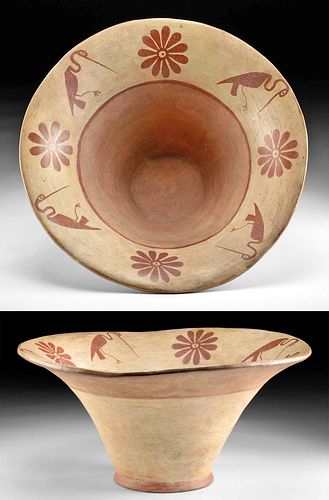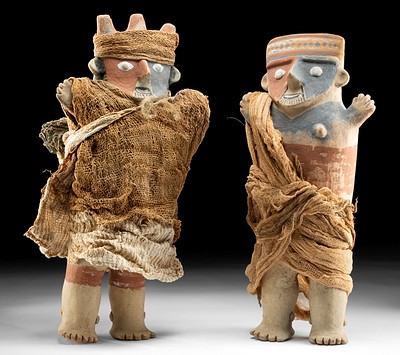Huge Moche Pottery Florero Floral & Avians
Lot 102a
About Seller
Artemis Fine Arts
686 S Taylor Ave, Ste 106
Louisville, CO 80027
United States
Selling antiquities, ancient and ethnographic art online since 1993, Artemis Gallery specializes in Classical Antiquities (Egyptian, Greek, Roman, Near Eastern), Asian, Pre-Columbian, African / Tribal / Oceanographic art. Our extensive inventory includes pottery, stone, metal, wood, glass and textil...Read more
Categories
Estimate:
$3,600 - $5,400
Absentee vs Live bid
Two ways to bid:
- Leave a max absentee bid and the platform will bid on your behalf up to your maximum bid during the live auction.
- Bid live during the auction and your bids will be submitted real-time to the auctioneer.
Bid Increments
| Price | Bid Increment |
|---|---|
| $0 | $25 |
| $300 | $50 |
| $1,000 | $100 |
| $2,000 | $250 |
| $5,000 | $500 |
| $10,000 | $1,000 |
| $20,000 | $2,500 |
| $50,000 | $5,000 |
| $100,000 | $10,000 |
| $200,000 | $20,000 |
About Auction
By Artemis Fine Arts
May 19, 2022
Set Reminder
2022-05-19 10:00:00
2022-05-19 10:00:00
America/New_York
Bidsquare
Bidsquare : Fine Antiquities | Ethnographica | Fine Art
https://www.bidsquare.com/auctions/artemis-gallery/fine-antiquities-ethnographica-fine-art-9350
Featuring a very special collection of Fine Art from the Hollywood Hills, including Picasso & Rookwood ceramics! Also included are many fine examples of classical antiquities, ancient, and ethnographic art from cultures encompassing the globe. Artemis Fine Arts info@artemisfinearts.com
Featuring a very special collection of Fine Art from the Hollywood Hills, including Picasso & Rookwood ceramics! Also included are many fine examples of classical antiquities, ancient, and ethnographic art from cultures encompassing the globe. Artemis Fine Arts info@artemisfinearts.com
- Lot Description
Pre-Columbian, North Coast Peru, Moche III, ca. 400 to 500 CE. A marvelous pottery florero of an impressive scale, richly adorned with floral and avian decoration in vibrant hues of burnt sienna, tangerine, and creamy vanilla. The elegant vessel boasts a dramatic silhouette with a circular foot, a conical body, and sturdy walls that span outwards to a broad, flared rim. Expertly hand-painted, the interior of the rim showcases a band of 4 pelicans in profile facing right alternating with 4 multi-petalled flowers. The stylized sea birds each stand on slightly bent legs presenting tucked wings, a flared tail, a sinuous neck, and an elongated, downward-pointing beak. Alternatively, the flowers each display a target-motif center and 9 to 11 extending petals. Size: 16.1" Diameter x 7.9" H (40.9 cm x 20.1 cm)
In ancient Peru, pelicans were admired for their adept skills, their wide wingspan, and their graceful flight; not to mention their ability to fly low just above the water to scoop a heap of fish in their large beaks and then drain the water though their bill which acts as a sieve. As inhabitants of the offshore Guano Islands, pelicans are among the rare producers of guano, a substance that was used as fertilizer by the Moche and later the Incas. To this day one can still see flocks of hundreds of pelicans nesting on these islands, a sight to behold both in ancient and modern times. The Moche and other ancient Peruvians believed that pelicans had the ability to dive into the world of the ancestors.
Florero bowls were generally reserved for ceremonial usage due to the supposed powers held within which could be employed by only the strongest of shaman. Regarding their use, author Jeffrey Quilter posits that they "perhaps…held materials used in healing. Possibly they were even filled with liquid to serve as divinatory mirrors, somewhat like crystal balls, enabling the user to see into the other world and find a cure" (Quilter, Jeffrey. The Moche of Ancient Peru: Media and Messages. Peabody Museum Press, Cambridge, Massachusetts, 2011, pp. 92). Shamanism and medicine were of the utmost importance to ancient Mesoamerican cultures like the Moche, so certain tools or vessels were created at the behest of the shaman so as to progress the advancement of medicinal remedies as well as to not upset the gods to which these shamans prayed and pleaded.
Provenance: private New York, New York, USA collection; ex-George Grossblatt collection, Greenwich Village, New York, USA, acquired in the 1960s, thence by descent to his widow, B.D., New York City, New York, USA
All items legal to buy/sell under U.S. Statute covering cultural patrimony Code 2600, CHAPTER 14, and are guaranteed to be as described or your money back.
A Certificate of Authenticity will accompany all winning bids.
PLEASE NOTE: Due to recent increases of shipments being seized by Australian & German customs (even for items with pre-UNESCO provenance), we will no longer ship most antiquities and ancient Chinese art to Australia & Germany. For categories of items that are acceptable to ship to Australia or Germany, please contact us directly or work with your local customs brokerage firm.
Display stands not described as included/custom in the item description are for photography purposes only and will not be included with the item upon shipping.
#172083Professionally repaired with restoration over break lines and repainting in areas. Some fire-darkening to underside of foot. Otherwise, excellent with impressive preservation of pigments and detail.Condition
- Shipping Info
-
All shipping is handled in-house for your convenience. Your invoice from Artemis Gallery will include shipping calculation instructions. If in doubt, please inquire BEFORE bidding for estimated shipping costs for individual items.
-
- Buyer's Premium



 EUR
EUR CAD
CAD AUD
AUD GBP
GBP MXN
MXN HKD
HKD CNY
CNY MYR
MYR SEK
SEK SGD
SGD CHF
CHF THB
THB















